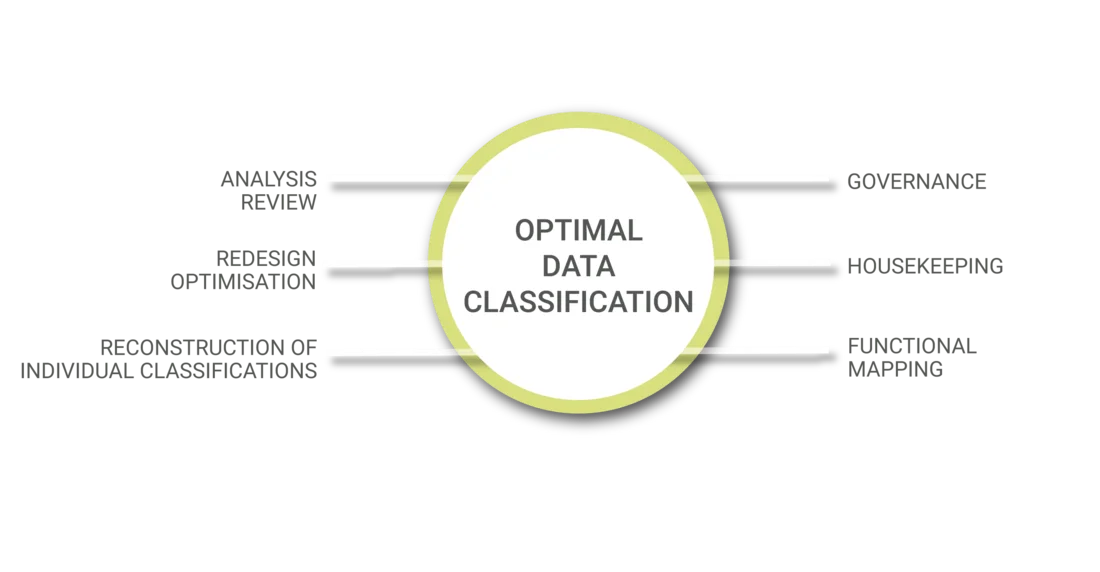Successful data management starts with data classification
Lay the foundation for efficiency and structure with product classification
Data classification plays a crucial role in organizing, securing and optimally using data. Structured classification facilitates quick access to information, reduces risks and supports compliance with legal requirements and industry standards. As a specialist in data management, forbeyond develops tailor-made classifications, optimizes existing structures and implements them seamlessly - for sustainable improvements and high-performance business processes.
What is data classification?
Data classification refers to the systematic categorization of data based on defined criteria such as sensitivity, usage or relevance. The aim is to structure data in such a way that it can be optimally managed and protected. This includes identifying data types, assessing their importance and assigning them to appropriate classes.
Why is data classification important?
In today's digital world, the volume of data is growing exponentially. Without a clear structure, companies can quickly lose track, leading to inefficiency, increased security risks and difficulties in meeting compliance requirements. Sophisticated data classification therefore offers numerous advantages:
Improved data quality:
Standardized classifications ensure consistent recording and maintenance, thereby increasing the reliability and quality of the data.
Increased efficiency:
Information is available more quickly, facilitates processes and accelerates decisions.
Increased security:
Sensitive data can be specifically identified and protected against unauthorized access.
Compliance:
Compliance with legal and industry-specific requirements is facilitated by clear data structures.
Requirements for data classification
Despite the obvious advantages, companies face various challenges when implementing data classification:
Data diversity
Standardized classifications ensure consistent recording and maintenance, thereby increasing the reliability and quality of the data.
Dynamics
Data is constantly changing, which requires continuous adaptation of the classification criteria.
Resource expenditure
The development and maintenance of a classification system can be time-consuming and resource-intensive.
Customized data classification with forbeyond: expertise and methodology combined
For the implementation of your requirements, forbeyond offers individually tailored service modules with experienced classification specialists. In doing so, we take a flexible approach to existing classifications, standard solutions, competitors and specific trade or industry requirements. Our structured approach ensures that every data classification is optimally tailored to your needs:

Analysis and review
Evaluation of the existing data structure and identification of optimization potential.
Optimization and redesign
Adaptation or redesign of the classification based on current requirements and best practices.
Reconstruction of individual classifications
Development of neutral core or publication classifications that can be flexibly adapted to different usage scenarios.
Governance
Introduction of guidelines and processes to ensure the long-term quality and consistency of the classification.
Housekeeping
Establish regular reviews and updates to ensure the relevance and accuracy of the classification.
Technical mapping
Alignment and integration of different classification systems to enable seamless data processing.
Whitepaper: Product Classification Practice Guide
In our white paper "Product Classification", we have compiled our best practices for dealing with standard and maintenance classifications.
Discover proven strategies and practical tips.
Standard classifications and individual customization
ETIM, eC@lss and internal classifications
Standard classifications such as ETIM and eCl@ss provide a solid basis for organizing product data consistently. They are based on industry standards, but are often less flexible for company-specific requirements.
An internal classification, on the other hand, allows processes and channels to be flexibly adapted to changing requirements.
The optimal solution is the combination of internal requirements and suitable industry standards. forbeyond creates this connection - also with the help of individual mappings - to structure your product data efficiently and get the maximum benefit from it.
Artificial intelligence (AI) in data classification
AI opens up new possibilities
- Automated classification: AI-supported systems can analyze and classify data in real time, which reduces manual effort.
- Adaptive systems: Dynamic classification models automatically adapt to changing data structures and content.
- Integration with modern data management systems: The seamless connection of classification systems with PIM-PXM or MDM solutions enables holistic data management.

